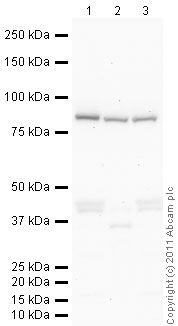Anti-Frizzled 7 antibody (ab64636)
Key features and details
- Rabbit polyclonal to Frizzled 7
- Suitable for: ICC/IF, WB, IHC-P
- Reacts with: Mouse, Rat, Human
- Isotype: IgG
Overview
-
Product name
Anti-Frizzled 7 antibody
See all Frizzled 7 primary antibodies -
Description
Rabbit polyclonal to Frizzled 7 -
Host species
Rabbit -
Tested Applications & Species
See all applications and species dataApplication Species ICC/IF HumanIHC-P HumanWB RatHuman -
Immunogen
Synthetic peptide corresponding to Human Frizzled 7 aa 550 to the C-terminus (C terminal) conjugated to keyhole limpet haemocyanin.
(Peptide available asab64635) -
General notes
The Life Science industry has been in the grips of a reproducibility crisis for a number of years. Abcam is leading the way in addressing the problem with our range of recombinant monoclonal antibodies and knockout edited cell lines for gold-standard validation.
One factor contributing to the crisis is the use of antibodies that are not suitable. This can lead to misleading results and the use of incorrect data informing project assumptions and direction. To help address this challenge, we have introduced an application and species grid on our primary antibody datasheets to make it easy to simplify identification of the right antibody for your needs.
Learn more here.
Images
-
All lanes : Anti-Frizzled 7 antibody (ab64636) at 1 µg/ml
Lane 1 : Skeletal Muscle (Rat) Tissue Lysate
Lane 2 : Human skeletal muscle tissue lysate - total protein (ab29330)
Lane 3 : Skeletal Muscle (Mouse) Tissue Lysate
Lysates/proteins at 10 µg per lane.
Secondary
All lanes : Goat polyclonal Secondary Antibody to Rabbit IgG - H&L (HRP), pre-adsorbed at 1/5000 dilution
Predicted band size: 64 kDa
Observed band size: 85 kDa why is the actual band size different from the predicted?
-
ICC/IF image of ab64636 stained MCF7 cells. The cells were 4% PFA fixed (10 min) and then incubated in 1%BSA / 10% normal goat serum / 0.3M glycine in 0.1% PBS-Tween for 1h to permeabilise the cells and block non-specific protein-protein interactions. The cells were then incubated with the antibody (ab64636, 5µg/ml) overnight at +4°C. The secondary antibody (green) was Alexa Fluor® 488 goat anti-rabbit IgG (H+L) used at a 1/1000 dilution for 1h. Alexa Fluor® 594 WGA was used to label plasma membranes (red) at a 1/200 dilution for 1h. DAPI was used to stain the cell nuclei (blue) at a concentration of 1.43µM. This antibody also gave a positive result in 4% PFA fixed (10 min) HeLa cells at 5µg/ml.
-
 Immunohistochemistry (Formalin/PFA-fixed paraffin-embedded sections) - Anti-Frizzled 7 antibody (ab64636) This image is courtesy of an abreview submitted by Antibody Solutions Ltd.
Immunohistochemistry (Formalin/PFA-fixed paraffin-embedded sections) - Anti-Frizzled 7 antibody (ab64636) This image is courtesy of an abreview submitted by Antibody Solutions Ltd.ab64636 (1/250) staining Frizzled 7 in paraffin-embedded Human kidney (papillary cancer) tissue. Tissue underwent fixation in formaldehyde, peroxidase blocking, protein blocking and heat mediated antigen retrieval. The secondary antibody was goat anti rabbit conjugated to HRP. For further experimental details please refer to abreview.
-
All lanes : Anti-Frizzled 7 antibody (ab64636) at 1 µg/ml
Lane 1 : Skeletal Muscle (Mouse) Tissue Lysate
Lane 2 : Spinal Cord (Rat) Tissue Lysate
Lane 3 : Human brain tissue lysate - total protein (ab29466)
Lane 4 : HEK293 (Human embryonic kidney cell line) Whole Cell Lysate
Lane 5 : HeLa (Human epithelial carcinoma cell line) Whole Cell Lysate
Lysates/proteins at 10 µg per lane.
Secondary
All lanes : Goat polyclonal to Rabbit IgG - H&L - Pre-Adsorbed (HRP) at 1/3000 dilution
Developed using the ECL technique.
Performed under reducing conditions.
Predicted band size: 64 kDa
Additional bands at: 90 kDa. We are unsure as to the identity of these extra bands.
Exposure time: 10 minutes
Frizzled 7 has a predicted molecular weight of 64 kDa, however as it contains a number of potential glycosylation sites (SwissProt data) it is thought that this is the reason it is running at 90kDa. Abcam welcomes customer feedback and would appreciate any comments regarding this product and the data presented above. -
 Immunohistochemistry (Formalin/PFA-fixed paraffin-embedded sections) - Anti-Frizzled 7 antibody (ab64636)IHC image of Frizzled 7 staining in human skeletal muscle formalin fixed paraffin embedded tissue section, performed on a Leica BondTM system using the standard protocol F. The section was pre-treated using heat mediated antigen retrieval with sodium citrate buffer (pH6, epitope retrieval solution 1) for 20 mins. The section was then incubated with ab64636, 1µg/ml, for 15 mins at room temperature and detected using an HRP conjugated compact polymer system. DAB was used as the chromogen. The section was then counterstained with haematoxylin and mounted with DPX.
Immunohistochemistry (Formalin/PFA-fixed paraffin-embedded sections) - Anti-Frizzled 7 antibody (ab64636)IHC image of Frizzled 7 staining in human skeletal muscle formalin fixed paraffin embedded tissue section, performed on a Leica BondTM system using the standard protocol F. The section was pre-treated using heat mediated antigen retrieval with sodium citrate buffer (pH6, epitope retrieval solution 1) for 20 mins. The section was then incubated with ab64636, 1µg/ml, for 15 mins at room temperature and detected using an HRP conjugated compact polymer system. DAB was used as the chromogen. The section was then counterstained with haematoxylin and mounted with DPX.











